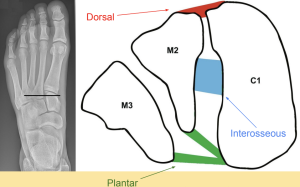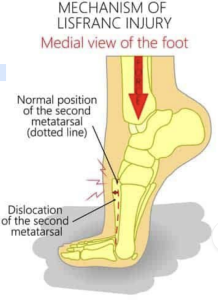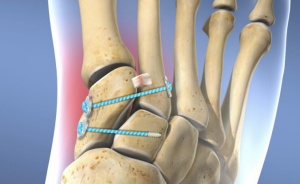Lis Franc Injuries
Written by Sasha Munchenberg - Podiatrist
Named after the French surgeon, Jacques Lisfranc de St. Martin, the Lisfranc ligament is made up of three bands and plays a crucial role in supporting the arch of the foot. The Lis Franc Joint compromises of the medial cuneiform, 1st metatarsal and 2nd metatarsal with the associated ligaments, joint capsule and conenctive tissue
A Lisfranc injury can occur when the forefoot is in a fixed position and a force is applied to the heel. The force applied to the rearfoot and heel can be downward such as being tackled while kicking in football or rotational, such as pivoting on the ball of the foot. Lisfranc injuries can also occur from impact trauma, such as car crashes and crush injuries, and from overuse.
The signs and symptoms of a Lisfranc injury includes:
- Midfoot pain
- Swelling
- Bruising
- A feeling of instability in the arch or inability to weight-bear
- Snapping or popping at the time of injury
If your podiatrist suspects a Lisfranc injury, they will refer you for imaging, usually an MRI, to get an accurate diagnosis and determine the severity of the injury.
The severity of the injury will determine the course and length of treatment. If the injury is severe, surgery may be required due to the importance of the Lisfranc ligament. If surgery is required, your podiatrist will be able to refer you to an orthopaedic specialist. Surgery can also be considered if conservative treatment does not achieve outcomes.
Both conservative and surgical treatments consist of periods of non-weightbearing and then offloading the foot in a CAM boot, usually a minimum of eight weeks. Because of the extended period of offloading required for the injury to heal, the muscles in the lower limb become deconditioned. Therefore, well-structured rehabilitation is crucial for return to sport and activity.
Your podiatrist will be able to guide you through this process. Podiatrists can prescribe you orthotics to support the Lisfranc ligament and arch of the foot, as well as provide footwear advice for the transition back into shoes. They will also create an exercise program to regain strength in the leg and foot and design a return to activity plan to help you achieve your goals.
Having had two Lisfranc injuries only eight months apart myself, I know how disheartening and frustrating it can be. However, with the support and guidance of my podiatrist I was able to achieve my goal of returning to netball. With proper Podiatric intervention, most people can return to sport and activity within three to nine months.



